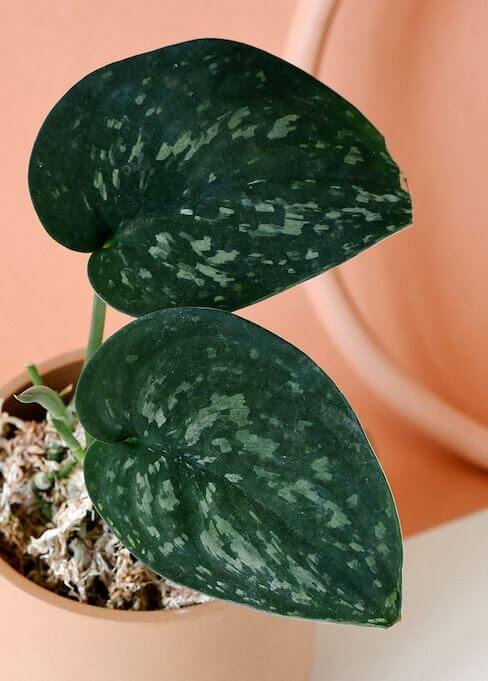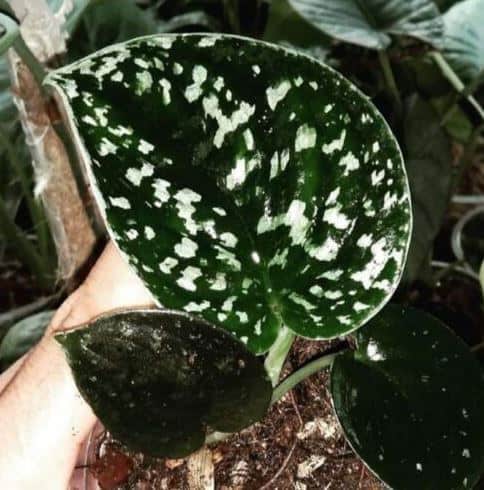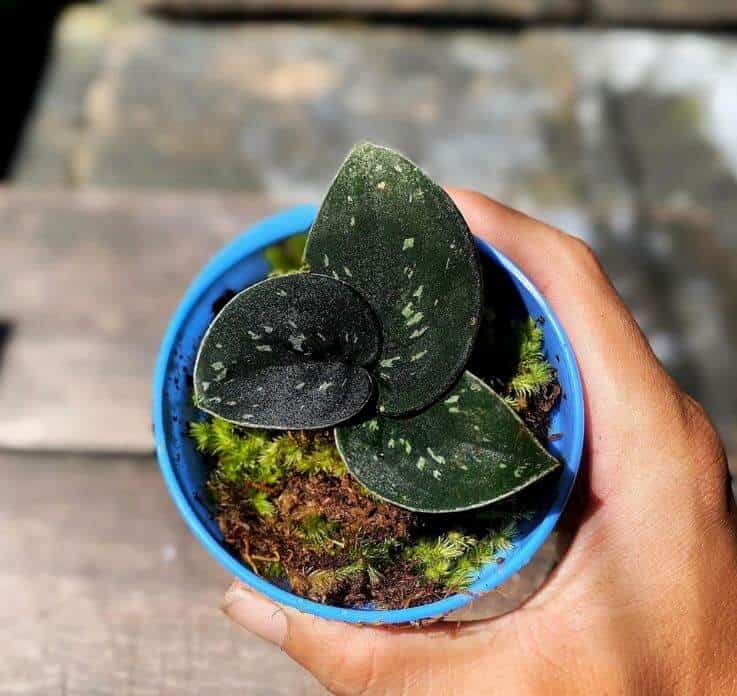Last Updated on January 5, 2023 by a Friendly Gardener
This beautiful and rare plant is a vining species of the Scindapsus that is characterized by dark foliage that appears to be almost black in hue. Silver variegation decorates the unusually colored leaves contributing to a stunning-looking houseplant.
The Scindapsus species are a wonderful kind of houseplant because they are easy to care for and not particularly demanding. Native to subtropical Asia, they thrive in indoor conditions and especially in average home humidity. This plant does prefer bright indirect light but will adapt to low-light conditions.
The Scindapsus Argyraeus Dark cultivar is a vining species, so it will spontaneously look for something to latch onto. It makes a lovely plant for a hanging basket, or you can provide a trellis or support pole. You can also choose to prune often for bushier growth. It is better to accommodate the plant’s climbing nature for foliage to develop completely.
In its native tropical habitat, vines can grow to ten feet and can be seen climbing up trees and other vegetation. Indoors, vines may reach about three feet in length.
Scindapsus Argyraeus Dark Plant Care

Velvety, heart-shaped leaves with sprinkles of silver grant this plant a uniquely attractive appearance for indoor home gardens or as office décor. This evergreen flowering cultivar is also nicknamed the Philodendron Silver or the Satin Pothos even though it is a member of the Scindapsus genus in the Araceae family. Blossoms are insignificant and this cultivar is mostly appreciated for its striking foliage.
This is a vining plant that is slow growing, so expect a young plant to need a few years to reach its mature size. You may note a spurt in growth during warm humid summer weather.
Soil

A fertile houseplant potting mix with excellent drainage is ideal for this plant. You can blend your own growing medium by mixing one part of bark and one part of perlite together with three parts of peat moss. This mix will guarantee adequate moisture retention but will not become soggy. You can opt to purchase a growing medium formulated for succulents and cacti. You can also use potting soil and amend it with coco coir or perlite to ensure drainage. Soggy soil can lead to root rot.
Light

Your Scindapsus Argyraeus Dark plant grows underneath dappled light in tropical forests, so it will thrive the most in very bright but indirect light. Generous bright light will help maintain the variegation of foliage. A nice hanging basket near windows that are east, or west-facing is ideal. Avoid direct sunlight, opting for a spot behind a sheer curtain or near the light source. Too much exposition to sunlight can scorch leaves.
Although this plant likes bright indirect light, it will adapt to low light conditions. But beware that too little light will cause variegation to fade, and leaves may become entirely green.
Water
As soon as the soil bed dries to about two inches deep, it’s time to water. Depending on your summer temperatures, you may need to water as much as twice a week. In the winter, watering should be significantly reduced. Insert your finger in the soil bed or use a plant moisture meter. When the soil is dry, water, but if the soil is damp, wait several days. Avoid watering on a strict schedule because this can lead to overwatering. Use the touch test.
Humidity
Ideally, your Scindapsus will do well in environments with 40% to 50% humidity, but they can do well in average household humidity levels. If you live in an arid location or have dry air due to heating or air conditioning, you may need to increase humidity with a pebble tray or space humidifier. You can also group houseplants together in one area to establish a microclimate. If leaf tips turn brown, low humidity is probably to blame.
Temperature
This Scindapsus grows very well in average indoor temperatures that measure between 65° and 85° F. Colder temperatures will damage foliage, so if your indoor temps drop below 60°F., move your plant to a warmer location.
This plant also does not like sudden temperature changes, so avoid spots that are subject to drafts. The Scindapsus should be kept away from air conditioning and heating elements.
Outdoor cultivation is possible in USDA hardiness zones 11 and 12.
Feeding
The Scindapsus Argyraeus Dark Plant will benefit from monthly feeding during its growing season. Dilute a balanced liquid houseplant fertilizer and apply it after you have watered. Interrupt fertilization during the fall and winter.
When fertilizing, beware that salts will build up in the soil bed and can burn your plant. Flush your plant out once every three months by running water through the soil bed. Beware of overfertilizing.
Pruning
Pruning isn’t really required. As a slow-growing vine, it needs several years to reach its mature full size. You will need to trim leggy stems to aid in the plant’s appearance. You can choose to prune to control the size of your plant or to achieve a bushier appearance. Trim stems to the desired length just above a leaf node.
Potting and Repotting the Scindapsus Argyraeus Dark Plant

Your Scindapsus will only need to be repotted every year or so because it is not a rapid grower. When your plant shows signs of being root bound such as roots peeking from drainage holes, it’s time to repot. When you repot, choose a pot the next size up to encourage growth.
Scindapsus Argyraeus Dark Plant Propagation

This plant can be propagated using stem cuttings. Snip a five-to-six-inch stem cutting with at least three leaf nodes. Trim the stem section below the leaf node and remove leaves from the lower half of the cutting. Place the stem cutting in a glass jar of water in a warm spot with bright indirect light. After several weeks roots should develop, and you can transplant your stem cutting into a growing medium.
Scindapsus Argyraeus Dark Plant Problems
While not particularly susceptible to pest infestations, it may occasionally fall prey to spider mites and scale. The scale which appears as waxy deposits on stems and leaves can be scraped off manually. It’s best to treat your plant with a neem oil solution or an insecticidal soap at the first sign of a pest infestation.
Root rot is the most common disease to affect this plant and it’s generally due to overwatering. Excess water and moisture in the soil will lead to fungal infection. Stems will turn mushy and dark and usually emit a foul odor. Remove your plant from the soggy soil and trim away diseased plant parts before repotting in fresh soil. Wait about a week before resuming watering.
Foliage may curl due to either under or overwatering, excessive heat, or a lack of sunlight. Foliage that turns brown is usually a result of harsh sunlight.
Scindapsus Argyraeus Dark Plant Toxicity
Unfortunately, the Scindapsus is toxic to dogs, cats, and other animals because it contains calcium oxalate crystals which will irritate the skin, cause drooling and swelling and make swallowing difficult. Keep your plant out of the reach of family pets and small children.


